I think I wrote software and read a lot. You know, just what I do today. Stuff like this:
This afternoon we concluded Sprint 84 with a boring deployment, which makes me happy. We've had only one moderately-exciting deployment this year, and even that one didn't take long to fix, so I'm doing something right.
Fifty years ago this week, steelworkers fastened the final girder to the tallest building in the world:
Placement of the beam — painted white and signed by thousands of Sears employees — ended nearly three years of construction that required Porzuczek and other ironworkers to climb up and down the steadily rising tower, wearing up to 70 pounds of tools around their waists.
The 110-story skyscraper at 233 S. Wacker Drive was topped out May 3, 1973. It ended the Empire State Building’s four-decade reign as the world’s tallest building and transformed the West Loop into a glittering office corridor.
“Along with the Standard Oil Building, it set the tone for the entire market,” said Goldie Wolfe Miller, who spent decades leasing downtown buildings. “All of a sudden, we became a mecca of first-class quality office buildings.”
The 443-meter Willis Tower lost its crown as world’s tallest in 1998, when it was surpassed by Malaysia’s Petronas Twin Towers, and the American title in 2014 when New York City’s One World Trade Center was completed. After decades of construction in Asian countries, it’s now the 23rd tallest in the world.
Superdawg, another Chicago institution turns 75 this month:
Whether it’s been for date nights, parties or just a quick snack, Superdawg has served generations of Chicagoans.
The iconic drive-in celebrates 75 years of business this month. The owners said they are maintaining its legacy by staying true to the original recipes, getting to know regulars and treating employees like a big family.
“Every day is special,” said Lisa Drucker, who co-owns the drive-in with her husband, Don Drucker, and her brother, Scott Berman.
Lisa Drucker and Berman’s parents, high school sweethearts Maurie and Flaurie Berman, created Superdawg in 1948, taking over the lot at 6363 N. Milwaukee Ave. and turning it into a destination for locals and tourists.
Happy birthday to both.
Graupel are snowflakes covered in rime ice. They're like big styrofoam snowflakes, and because they form in warmer air, they melt almost immediately on contact with anything solid. Yesterday the Chicago Tribune had a handy explainer on the back page, just in case people were curious what was hitting them on the head standing on "temporary" railway platforms this morning. (Fuck Bruce Rauner and his entire party.)
Sorry. I get a little grumpy when I wake up on May Day to mid-March weather. With graupel.
A plethora:
- Google has updated its satellite photos of Mariupol, clearly showing the destruction from Russia's invasion and subsequent siege.
- Senators Angus King (I-ME) and Lisa Murkowsky (R-AK) have introduced legislation to force the Supreme Court—read: Justices Thomas (R$) and Gorsuch (R)—to adopt a binding code of ethics. Presumably a Democratic bill that would actually let Congress set the Court's ethical standards will come soon.
- On Monday, the city will cut down a bur oak they estimate has lived over 250 years.
- The US Army will rename a Virginia fort after Lt. Gen. Arthur Gregg and Lt. Col. Charity Adams, replacing the name of a disgraced traitor named Robert E. Lee.
- Carolyn Bryant Donham, whose false accusation that teenager Emmett Till whistled at her resulted in her fellow racists lynching the boy, died on Tuesday at 88.
- Emma Durand-Wood discovers what many of us already knew: having a fitness tracker, and getting your steps in, makes you very aware of walkable environments.
- Nicholas Dagen Bloom's new book explains why public transit in the US has done poorly for the last 75 years (hint: racism).
- Max Holleran suggests a way to make US cities cleaner (and encourage more public transit use): make parking impossible.
- Bruce Schneier suggests a publicly-funded AI could help save democracy—or at least offset the likely harms from only having privately-owned AIs.
- Three Colorado teens face murder charges after an evening of throwing rocks from an overpass killed a 20-year-old driver.
- In a less destructive prank gone wrong, seniors at Northridge Prep, a Catholic high school in north suburban Niles, accidentally let a steer loose in the village this morning.
Finally, as we approach the 50th anniversary of Gary Gygax creating Dungeons & Dragons, Christopher Borrelli suggests putting a statue of him up in downtown Lake Geneva. I concur. Or, since he spent the first seven years of his life just a few blocks away from where I'm sitting right now (on Kenmore near Wrigley Field), why not put one there, too? (One of my favorite memories from childhood is playing 5 minutes of AD&D with Gygax as DM.)
Cassie and I had a lovely time yesterday afternoon. I grabbed some pizza at one of my childhood favorite places, then we did a 5½ kilometer walk around the Skokie Lagoons:
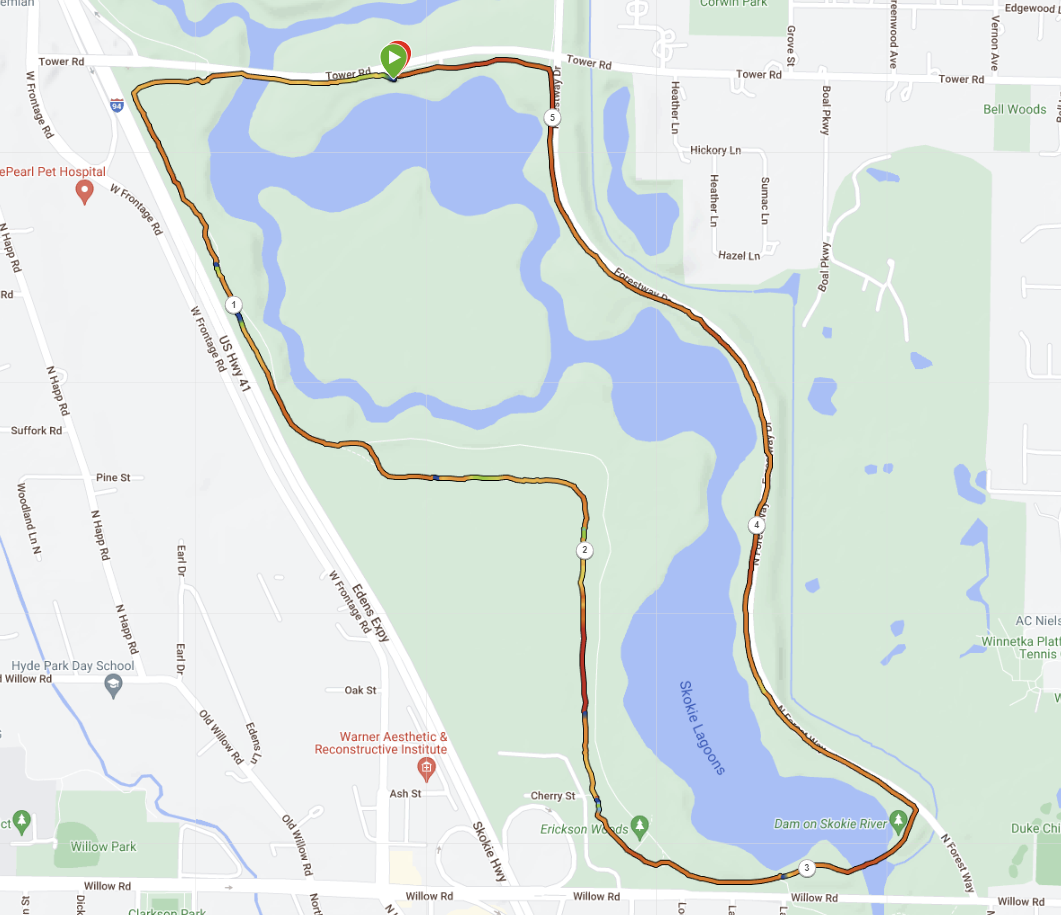
She seemed to enjoy it:

Later this afternoon I'll jot down all of the news I didn't read while having a great time in the forest yesterday.
I got an update today from Metra about the Ravenswood Union Pacific North station, after sending an inquiry last week. Before I get to that, let's take a look at photographic evidence that we've had to use the "temporary" platform north of Lawrence Avenue for just under 12 years now:
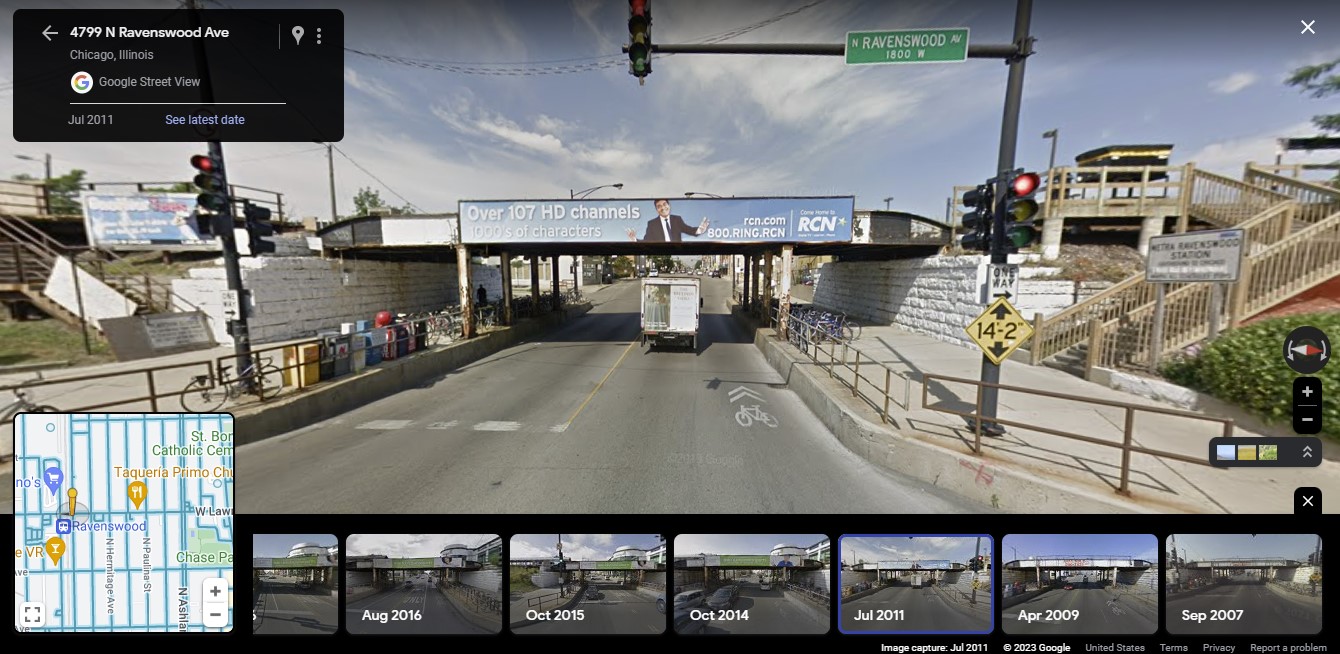
That's the Google Street View from July 2011 showing that Metra has already closed the 1950s-era inbound platform (on the left) and opened the "temporary" platform (on the right).
I took these two photos a week ago, but I could have taken them last September with only one minor change (the new "temporary" fence by the entrance to the new platform):
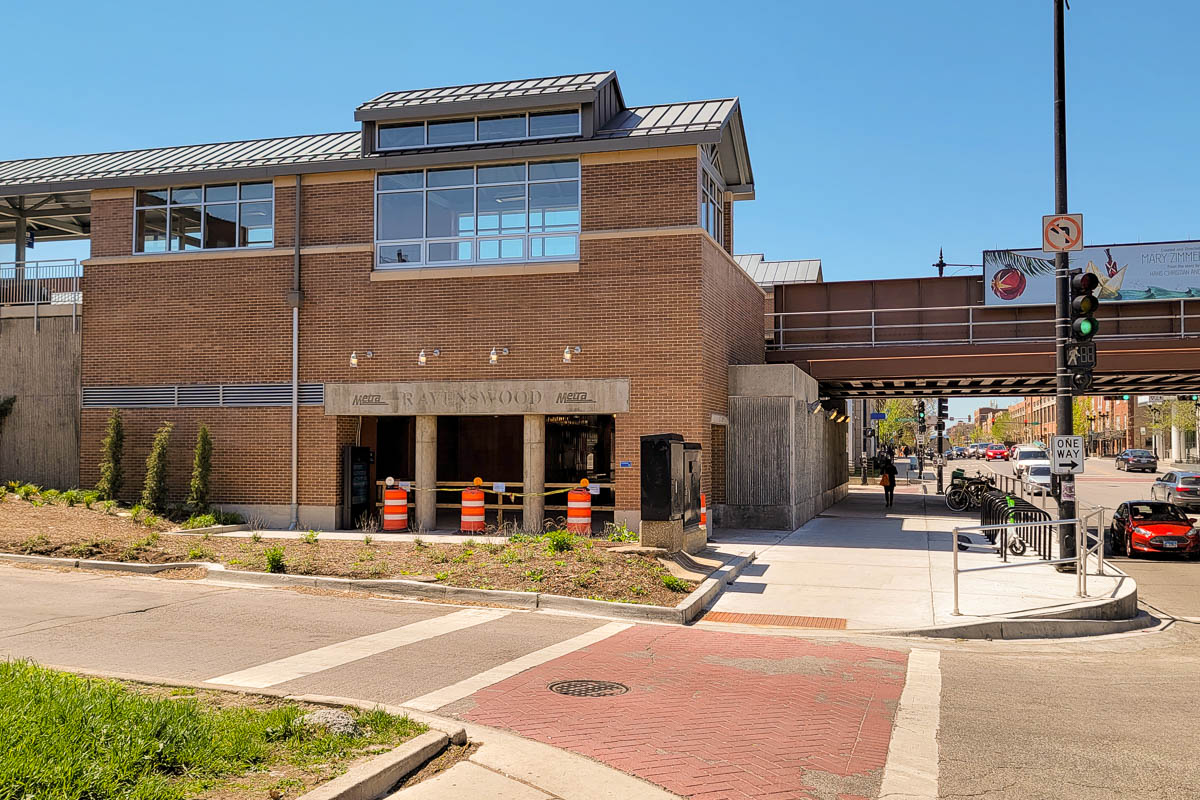
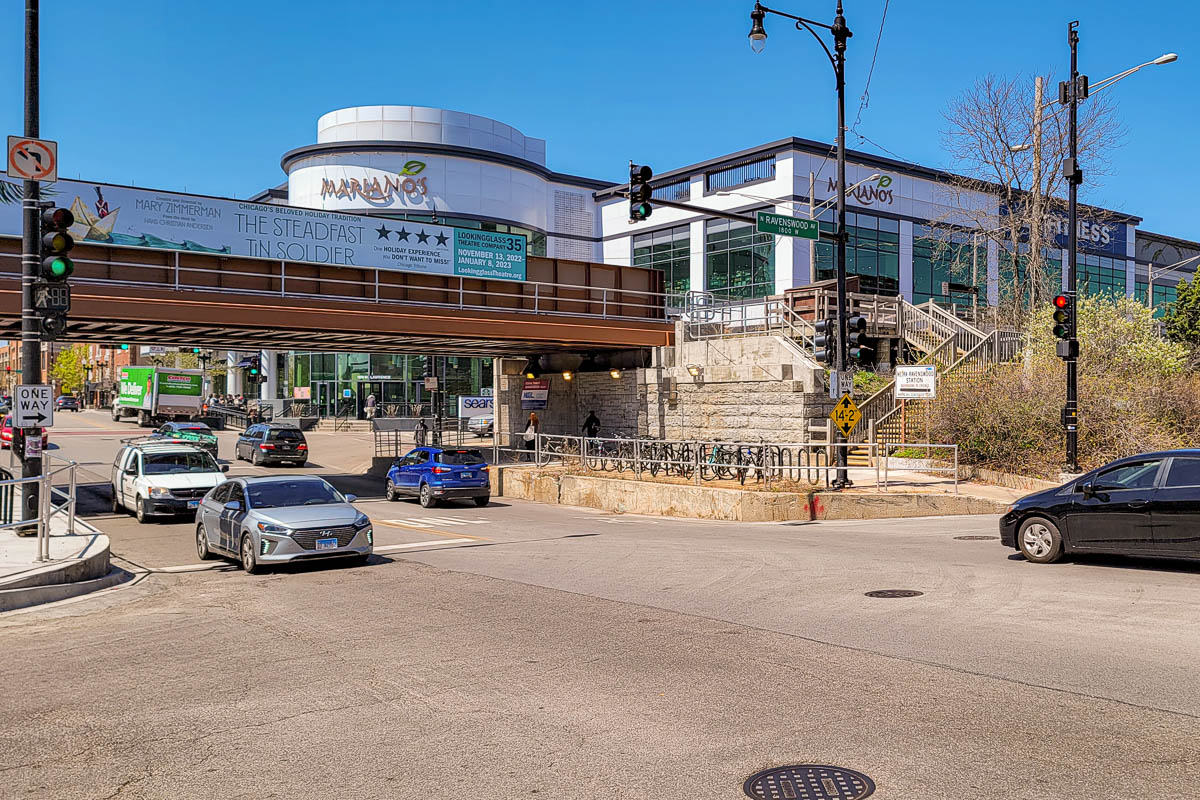
OK, so now that we've established that (a) we haven't had even a semi-permanent inbound platform since the middle of President Obama's first term, and (b) neither Metra nor the UPRR has done any noticeable work on the new new-but-unfinished platform since I last posted news seven months ago, here is what a Metra spokesperson told me this afternoon:
Per our station project Construction Team, a late July 2023 completion is anticipated. There are a few items remaining that need to be addressed to complete the project.
- Structural tiles, which the manufacturer has delayed delivery of. Our Team has 3 other options to address this issue that they are looking into and are actively progressing a tile alternative.
- The waterproofing along the edge of the platform and the bridge abutment (Lawrence & Leland) that requires the removal of track and ballast by Union Pacific Railroad will be scheduled by UP forces. Ballast work could not be performed during winter months when ground is frozen.
- Guardrail fencing change work at Leland Bridge is proceeding through redesign to accommodate a conduit system. Contractor estimates work end of May/early June.
- A solution to the hairline cracks in the platform surface has been determined. A coating to address this issue cannot be applied until weather conditions permit.
- Additional CDOT crossing work required along with the asphalt overlay patching in the street cannot occur until the asphalt plants reopen next month.
With a project of this magnitude that entailed the replacement of 22 bridges on the UPN Line, as well as a complete station project, its impact on the community was/is unavoidable and cannot be understated. Metra is making every attempt possible to improve the dates on the remaining items and complete the work, as soon as possible.
I knew about #3, and previously reported about #1. The rest just frustrates me to no end.
The UPRR and Metra should have completed this project in 2018. I will remind everyone that four years of the delay happened because former Illinois governor Bruce Rauner (R) cut funding to everything based solely on his extreme anti-government ideology. (Makes you wonder why he wanted to govern, right?) And once again, I will remind everyone that if I had the power, I would sentence the former governor to stand on the platform for two hours a day, every day, for a duration equal to the entire delay to the project that he caused. Even that sentence seems lenient.
I hope that my contact at Metra has accurate information, because I'm really tired of standing in the rain just 20 meters from what appears to be a perfectly serviceable but inaccessible shelter.
As professional narcissist Elon Musk threatened, on Thursday Twitter abruptly ended their verified "blue check" program. Suddenly, Twitter users had no way to know for sure whether tens of thousands of government agencies, celebrities, journalists, and other people whose jobs depend to some extent on their credibility, were who their Twitter accounts purported to be.
It only took two days for someone to hoax the City of Chicago:
Impostors posing as Chicago government officials, including Mayor Lori Lightfoot, posted a series of tweets early Friday morning falsely claiming that North Jean Baptiste Point DuSable Lake Shore Drive is being permanently closed.
The accounts posting the false tweets claimed to be Lightfoot, the Chicago Department of Transportation and the Illinois Department of Transportation. Their posts were seen by well over 100,000 people early in the day, according to Twitter data.
The impersonation effort came just a day after Twitter removed verification from accounts that had been previously verified for the purpose of credibility. Twitter CEO Elon Musk’s controversial decision to remove the “legacy” verifications took away the authenticated status of all three of the impersonated accounts.
Before Friday, the usernames of the true mayoral account, CDOT account and IDOT account had all previously appeared alongside a blue check mark signaling that the accounts had been proved to actually represent the authorities they claimed to represent. However, those check marks were taken away Thursday because of Musk’s decision.
New York City's government also had their own problem.
But this highlights a real problem: in a disaster, or an election, how will people know what information is real? I think "by not using Twitter" seems like the right answer but I also don't think Twitter will fully die by next November.
I didn't publish on Twitter very much before. Today, I'm just standing on shore, watching the ship sink. But it's a big ship, and its sinking will foul the environment for a long time.
How my week is going so far. Wednesday evening:

Yesterday evening:
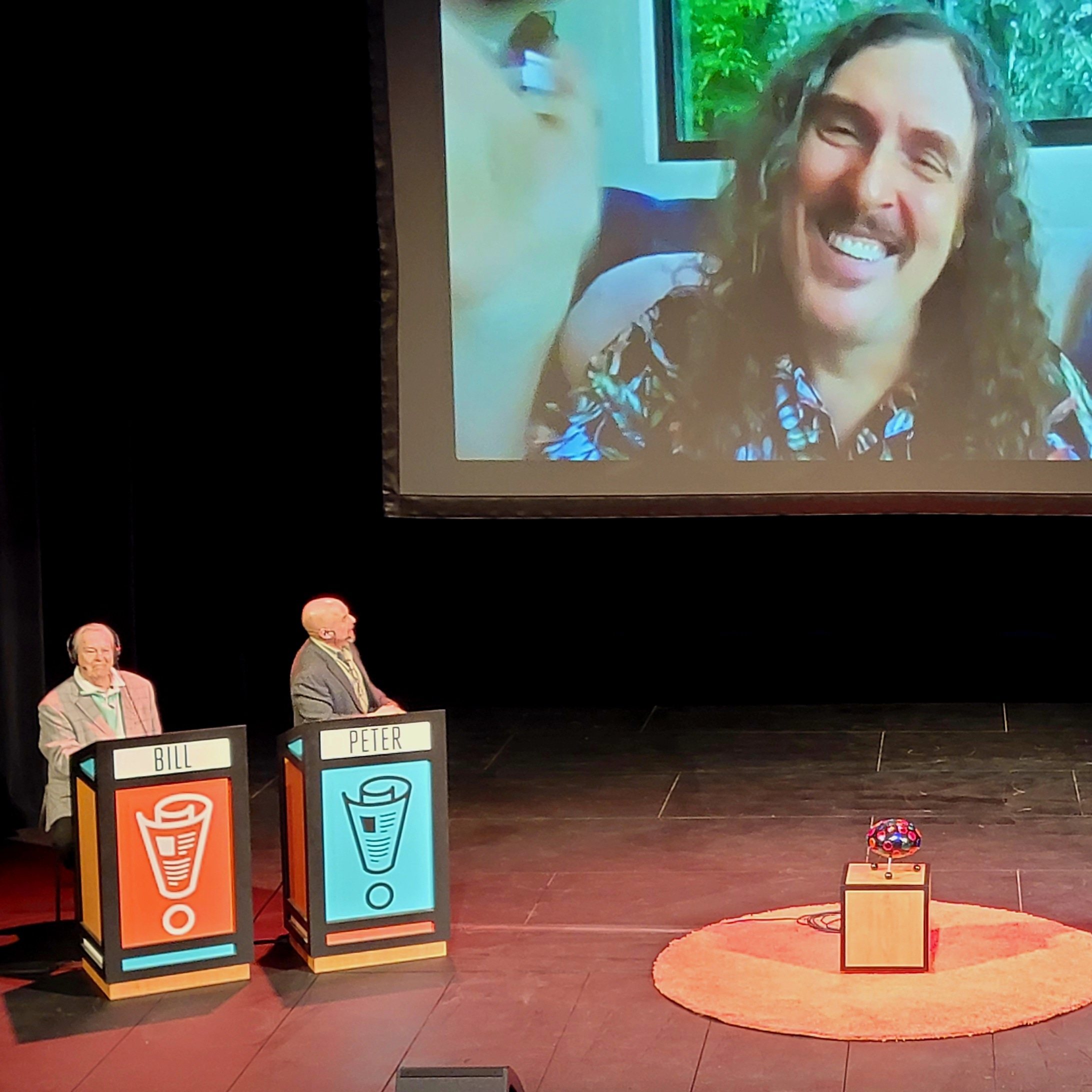
You can hear Weird Al on NPR's Wait Wait...Don't Tell Me! this weekend.
First, because it's April 20th, we have a a couple of stories about marijuana:
(The Daily Parker owns shares in Chicago-based Green Thumb Industries.)
Second, because it's the 21st Century, we have a collection of articles about the end of democracy:
And in me. I've got software to write.
Freelance writer John Carpenter (a "husky man of 60, with the approximate flexibility of a rusty old tractor") explores some of the abandoned railroads that now have bike paths on them in the Chicago area:
Chicago is teeming with them — rail trails, I mean. Once extolled by the poet Carl Sandburg as the “player with railroads and the nation’s freight handler,” it remains a national railroad hub. That means there are bike paths along existing lines, like the Green Bay Trail beside Metra’s North Line, and trails along the roadbed of long-abandoned lines, like the west suburban Illinois Prairie Path and the city’s Bloomingdale Trail, also known as The 606.
Chicago is also home to a stretch of the Great American Rail Trail, a 6,000-km bike path from coast to coast that passes through northwest Indiana and the south suburbs. Though supported by the national Rails to Trails Conservancy, it is really a network of more than 125 locally backed trails that is still filling out some gaps in the run from Washington, D.C., to the Pacific Ocean west of Seattle. I did a relatively short stretch in Indiana, and it left me wanting to ride more.
The magic of rail trails is rooted in the laws of physics. Massively heavy freight and passenger trains simply cannot handle steep grades up and down. That’s why tracks are built up on bridges and artificial berms in some places, and carved into the land in others, leveling out elevation changes to allow trains to move up and down at a gentle rate.
The result is that riders can easily get into a comfortable cruise. One can maintain a pleasant speed with a steady churn in the higher gears, pushing hard enough to get the heart beating, without the extreme strains of steep uphill slogs. There is also the satisfaction of feeling the miles click away.
He identifies the North Shore trail as "along" a right-of-way, but in fact it covers the old North Shore Line, abandoned in 1964. I used to ride that trail a lot when I was a kid. These days, I sometimes walk a long stretch of it.